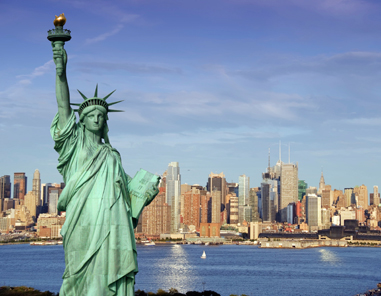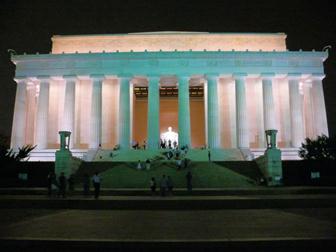About the United States of America
Country Profile & Facts
- Official Name: United States of America
- Name Origin: America is named after the Italian explorer, Amerigo Vespucci
- Capital: Washington D.C.
- Date of Independence: July 4, 1776
- Size: 9,826,675 km2
- Population: 308,745,538 (U.S. Census 2010)
- Motto: “In God we trust”
- Largest Cities: New York City, Los Angeles, Chicago, Houston, Phoenix, Philadelphia
- Largest State: Alaska
- Languages: English 82%, Spanish 11%, others
- Currency: United States Dollar ($)
- International Dial Code: +011
U.S. Geography/Culture

Mount Rushmore, South Dakota
From the cool and remote coastline of Maine to world-class cities like New York and Los Angeles that never sleep, from the wide prairies of America’s heartland states, to the towering peaks of the Rocky Mountains, the United States is one of the world’s most geographically diverse nations. Likewise, a s t he product of more than 500 hundred years of large-scale immigration with more than 308 million people, the U.S. is one of the world’s most ethnically diverse and multicultural nations. Founded on July 4, 1776, the U.S. is comprised of 50 states and a federal district, Washington, DC. Visitors to the U.S. are often surprised by the distance between metro centers, favorite historic sites, and popular attractions as the nation spans 3.79 million square miles (9.83 million square kilometers). Forty-eight contiguous states extend across the width of the North American continent from the Atlantic Ocean to the Pacific Ocean; Mexico lies to the south, with Canada to the north. The 49th state, Alaska, is north and west of Canada; the archipelago of islands that make up the 50th state, Hawaii, lie 2,500 miles (4,023 kilometers) off the coast of California near the middle of the Pacific Ocean.
Food

New York City
Mainstream American cuisine is similar to that in other Western countries. Traditional American cuisine uses indigenous ingredients, such as turkey, venison, potatoes, sweet potatoes, corn, squash, and maple syrup, which were consumed by Native Americans and early European settlers. Slow-cooked pork and beef barbecue, crab cakes, potato chips, and chocolate chip cookies are distinctively American foods.
Climate
Summers vary considerably in the U.S., but late July in Washington, DC. is reliably hot and humid. Expect average temperatures around 88° F (31° C) and bring light clothing. Buildings are generally well air-conditioned, so a light sweater may be handy.
About Washington, D.C.

U.S. Capitol Building
Officially founded on July 16, 1790, Washington, DC, is unique among American cities because it was established by the Constitution of the United States to serve as the nation’s capital. From the beginning it has been embroiled in political maneuvering, sectional conflicts, issues of race, national identity, compromise and, of course, power. In addition to being the headquarters for the U.S. government, Washington is home to many of the nation’s most famous monuments and museums, including the extensive and varied holdings, known as the Smithsonian.
Washington is also a cosmopolitan city. While it has always had foreign delegations from the countries of the world it also boasts an increasingly diverse ethnic population. A growing Latino population represents every Central and South American country with a particularly large community of Salvadorans. A large Ethiopian population has resulted from the political turmoil there. New ethnic groups have brought new restaurants, as well as new residents. While DC lost residents to surrounding suburbs in the 1990s, new housing and urban revitalization is now attracting people back to the city for a downtown renaissance of housing, offices, entertainment and nightlife.

Washington, DC - Mall
After 217 years as the nation’s capital, Washington is a place brimming with a unique history of its own. It has developed as a complex and layered city with multiple personalities. As home to the federal government, it has attracted a diverse mix of government workers, members of Congress from every state, foreign emissaries, lobbyists, petitioners and protestors. While elected and appointed officials come and go giving the city its reputation as a transient community, many of the city’s residents have called Washington home for multiple generations. Their stories give Washington its distinctive character as both a national and local city.
The greater Washington area hosts 174 foreign embassies as well as headquarters of the World Bank, the International Monetary Fund (IMF), and many other institutions, universities, lobbying groups, and professional societies. Washington, D.C., had a resident population of 601,723 in 2010. Commuters from the surrounding Maryland and Virginia suburbs raise the city's population to over one million during the workweek. The Washington Metropolitan Area, of which the District is a part, has a population of nearly 5.6 million, the seventh-largest metropolitan area in the country.

Lincoln Memorial
DC welcomes approximately 15 million visitors each year, generating an estimated $5.24 billion in visitor spending for the city alone. Approximately 1.2 international visitors come to DC annually. Top countries of origin include: United Kingdom, Germany, Latin America (Brazil, Argentina, and Mexico), Japan, India, South Korea, Nordic (Denmark, Finland, Norway, Sweden), Australia, Italy and France.
Main Attractions include:

Georgetown Waterfront
- Smithsonian’s: National Museum of Natural History (7 million visitors)
- National Air & Space Museum (6 million visitors)
- National Museum of American History (3 million visitors)
- National Zoological Park (3 million visitors
- Lincoln Memorial (4 million visitors)
- World War II Memorial (4 million visitors)
- Vietnam Veterans Memorial (4 million visitors)
- Korean Memorial (3 million visitors)
- FDR Memorial (3 million visitors)
- Rock Creek Park (2 million visitors)
DC is also home to 4 major sporting event venues and 8 major professional teams including the Redskins, Wizards, Mystics, Nationals, United and Capitals
There are more than 40 performing arts/theatre venues.
Green Initiatives
- 70 percent of land in Washington, DC is controlled by the National Park Service. There are 250,000 acres of parkland in the Greater Washington Metropolitan area.
- In 2007, DC was named the most walkable city in the US in a study by the Brookings Institute.
- In late 2006, City Council passed an initiative making the nation’s capital the first major city to require developers to adhere to guidelines established by the U.S. Green Building Council.
- The Washington Nationals Ballpark is striving to be the country’s first green-certified ballpark
- DC’s hotels have implemented green initiatives, including wind power, renewable energy credits, recycling and adopt-a-park programs with neighborhood green spaces.


